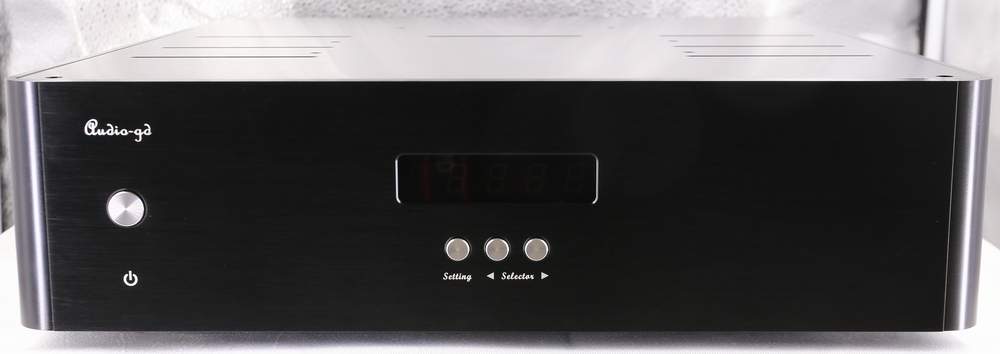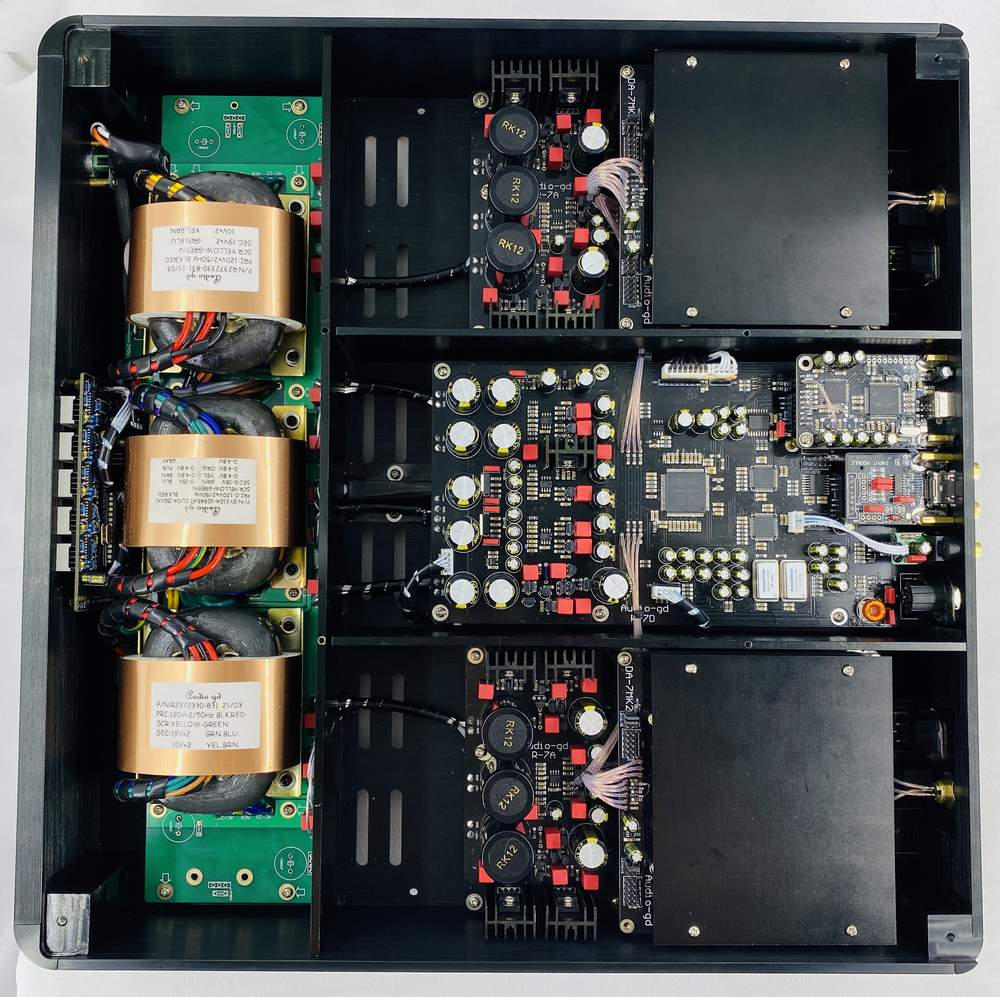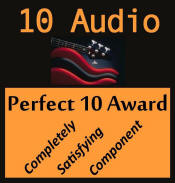Audio-GD is a new brand here in the U.S. Distributed by Underwood HiFi (link below) in the US, Audio-GD is a Chinese company that makes a wide range of audio products including DACs, headphone amplifiers, preamps, and power amplifiers. Their motto is “Wisdom in mind, enthusiasm at heart”. From their Web site:
“All Audio-GD’s products are designed and developed under the leadership of Mr. He Qinghua, the “First Prize Winner” of the National Semiconductor (USA) Audio Design Contest.
“With strong research and development capability in audio technology, Audio-GD offers a complete series of Hi-Fi equipment with our signature “Audio-GD Current Signal System“ (ACSS) technology. Our ACSS technology transmits all audio signals via “Current” domain which offers the least colored, most detailed and neutral sound. In addition, we also master advanced audio technologies like power regeneration technology and full balanced audio technology.
“Audio-GD has been growing steadily over the years and is renowned amongst local and foreign customers. We insist on the build quality with no compromise. To ensure the best quality, every technician of our company is not only well experienced but also a Hi-Fi lover.”

As you can see in the images below, the R7 MK2 is not some bare-bones DAC. Instead, the R7 MK2 is a full sized, well-engineered, R2R ladder design with a power supply that could run a power amplifier. You get a lot for the $3,750 purchase price. There is one model higher up in the product line, the R7HE MK2, which, at $4,990, is basically the same as the unit reviewed here but also includes a built-in regenerative power supply. A 2 year US warranty is standard, with 10 years by the factory.
Here are some features of this DAC:
– Fully discrete parts are used in a truly balanced current transmission design.
– 4 sets of fully discrete and independent DSD hardware decoders.
– 8 sets of fully discrete R-2R DA modules to form a two-channel balanced push-pull decoder.
– 2 reference Accusilicon Femto clocks provide synchronization for the DAC. They are applied to the playback of all data rates without PLL up-conversion.
Editor’s note: Yes! DACs should not automatically up-convert because the manufacturer’s up-conversion frequency might not be optimum. For example, a 44.1 kHz CD sounds best when up-converted (upsampled) 4 times to 176.4 kHz, NOT 4.353741496598639 times to 192 kHz. (Simple math seems to sound better.) A discerning listener will want to select the up-conversion based on the resolution of the recording or media file.
– 32bit / 384K asynchronous Amanero USB interface synchronized with the FPGA. USB and HDMI modules are equipped with galvanic isolators and fed by two groups of independent isolated power supplies, to avoid the mutual electrical contamination between USB and HDMI.
– The DAC uses a discrete servo stabilized power supply, whose performance is advertised as comparable to batteries. The digital circuit uses discrete servo stabilized power supplies, while the clock and the analog circuits are powered by pure class-A power supplies to achieve the best sound, as determined during listening tests.
– The digital circuits of the whole DAC are comprised of 1 FPGA and 7 programmable chip sets which allow separating the different functional circuits and preventing interference.
– The FPGA (Field Programmable Gate Array) operates in the parallel data processing mode even at the fastest data rate, and supports firmware upgrades.
– The input signal sampling rate is displayed on power up.
– Support of an external 10MHz clock input.
– A firmware upgrade port on the rear panel of the machine.

You can find more discussion and details about the product design on the Audio-GD.com Web site. Here’s a very interesting discussion about R2R ladder DACs, and why the programmable FPGA is necessary:
Many people care about the accuracy of the step resistances because they think that R-2R depends essentially on the accuracy of the resistance.
Nowadays, 24 bit is a standard, but can the precision of manufactured resistors reach 24-bit? Even with only 16 bits, the accuracy requirement is 1/66536, and so 0.1% (1/1000) of accuracy is completely inadequate. In fact, 0.01% (1/10000) would still fail to meet the 16-bit requirement, let alone 24-bits. (Editor’s note: Resistors are available at 0.01% accuracy/tolerance. As accuracy increases, so does cost.)
Therefore, improving accuracy of the resistance is not enough to solve the problem. If there were 0.00001% resistors available on the market, it would meet the requirement of 24 bits, but the inherent resistance of the switching devices would completely wipe out this super high accuracy advantage.
We need to solve the problem technically, not just improve the accuracy of the resistance. But we still use ultra-high precision resistors in our products.
–Back to the review.

Other components on hand during the audition and review include Acoustic Signature Montana Neo turntable with Acoustic Signature TA-7000 Neo and Origin Live Agile tonearms; ZYX UNIverse Optimum and Miyajima Destiny moving coil phono cartridges; BMC MCCI ULN phono preamplifier; Soulution 325 with phono, Pass XP-22, and Benchmark HPA4 preamplifiers; digital is handled by a custom Windows 10 computer running JRiver Media Center with a USB-connected Marantz SA-10 DAC, and RME ADI-Pro 2 Black Edition AD/DAC with external power supply; Valvet E2 SE and Benchmark AHB2 power amplifiers; Alta Audio Celesta FRM-2M and Magico S1 MkII speakers, and the Magicos are lightly augmented in the low bass with a pair of JL Audio e110 subwoofers. The audio cabling is Audioquest WEL Signature and Mogami interconnects and speaker cables. USB cables are StraightWire USB-F. Power protection and purification are provided by a PS Audio Dectet for the preamplifiers and source components, and a PS Audio Quintet for the power amplifiers. The Quintet includes a standard 1/8″ trigger connection enabling remote turn-on and -off of power amplifiers that lack a 12V remote trigger. Power cords include my DIY power cord, and Straight Wire Pro Thunder. An Acoustic Signature Grip, Origin Live Gravity One, and the new Stillpoints Ultra-LPI mk2 record clamps were employed during the review period.
The DAC received 500 hours of conditioning or break-in prior to serious listening, including the 100 hours which is already done at the factory. As with most new electronics, the initial sound was a little brittle and edgy, but after just a few hours the R7 was very listenable. The operation of the DAC is completely silent, with no clicks or other indication that it has locked onto a different sample rate.
Listen to Sibling Rivalry by the Doobie Brothers. The cut “Leave My Heartache Behind” pops with dynamics and definition that propels even Red Book CDs to a new, higher ground. Don’t be afraid if you can’t stand to lose this quality. Nothing in the five corners of the planet can take this away from an ordinary man, even if he is standing on the 45th floor. See the album track list for a better understanding of this paragraph.
“Sweet Annie” on the Zac Brown Band’s Uncaged album is powerful and involving. The voices are clear and it is an easy mental shift to focus on a different voice or instrument. Or just suspend critical listening and enjoy the performance – any performance. This is the meaning of “high-end sound”.
A good recording for huge dynamics is “Coming Home” by Keith Urban with Julia Michaels on Keith’s 2018 Graffiti U CD. Julia’s voice is crystal clear and her words are easily understood. The R7 pulls an amazing amount of very low-level detail from digital recordings and does an excellent job of meeting the depth and tone standards set by LPs. The complex sounds of cymbals – a rigorous test of any audio component – ring true. Voices have a presence and naturalness that honors each and every singer.
The treble is smooth and extended, nicely detailed but not harsh or overly bright. This DAC should sound great in any system, but possibly favor a system that has a small tendency towards a cooler or more forward sound. The R7 is not soft or lacking in the upper frequencies. On the contrary, the delivery is clean, extended, transparent and high resolution. After upgrading the A-D converter to the latest RME ADI-2 Pro Black Edition, it takes some effort to hear the difference between an LP playing and a 32-bit 192 kHz recording of that same LP.

It seems that whole number upsampling is best. When recordings are upsampled, notes seem to gain a degree of individuality and separation from the mix. Each sound more assuredly stands on its own, but is also integrated into the performance as a whole. Keep in mind that the CPU or processor of your device is likely 64-bit. From CDs ripped at their native 16-bit 44.1 kHz into WAV files, and upsampled to 32-bit (2x) 176.4 kHz (4x) in JRiver Media Center, the R7 delivers very deep resolution which is wonderfully analog-like in warmth and believability. These files upsampled 8x and sent to the R7 at 352.8 kHz can sound somewhat coarse and hard, possibly the fault of the upsampling algorithm, and not the DAC. The Audio-GD R7 MK2 sounds better and more lifelike than the 10 LP-rated Marantz DAC and sets a higher standard in this cost class and above. This is a major upgrade.
When a DAC can convey thunderous bass, outstanding vocals, clear & extended treble, and a huge soundstage with the air of open space, it will certainly provide long-term listening satisfaction. The main challenge for this DAC is really a challenge for you: the R7 is so musical and resolving that it needs high quality recordings to sound like a high-quality DAC. Give it an early digital recording, maybe from the 1980s, and you will definitely hear the immaturity of the technology. Feed the Audio-GD R7 MK2 with high quality, high resolution recordings, and you will not be surprised when the term “upgrade” fades from your thoughts. This could be THE ONE.
Overall Rating: 10 LPs

Link to distributor: Underwood Hifi
This review would not have been possible without the very kind support of Walter at Underwood Hifi. Thank you, Walter!
